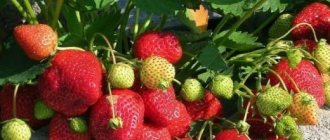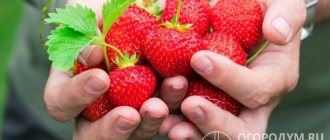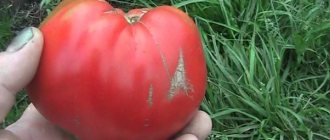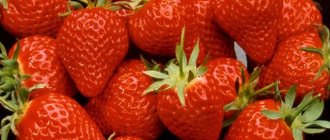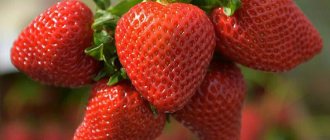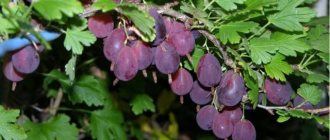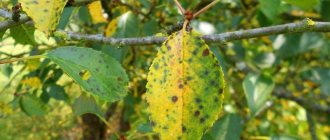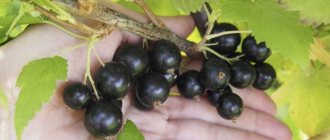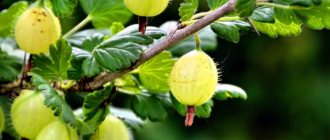Strawberries "Lord" are very popular among lovers of large, sweet berries. Despite the fact that the variety is not listed in the State Register, it has been familiar to many Russian summer residents and gardeners for quite a long time, and is widely cultivated in folk selection.
Strawberries "Lord" (pictured) under favorable conditions can gain weight up to 100 g
There is no exact information about the origin of the variety; most sources attribute it to British selection, but in Russia it has been known since the 80s of the last century. Strawberries “Lord”, according to reviews from gardeners, are unpretentious in care, resistant to common diseases and pests, adapt well to various climatic and weather conditions, provide stable yields not only in the southern regions or Ukraine, but also in the middle zone, Moscow region, the Urals and in Siberia. According to experts, the variety has high potential and profitability of production (100.8-134.4%) and is recommended for commercial cultivation.
Characteristics of the variety
This variety boasts quite large berries. Lord is also famous for its high resistance to weather conditions. The bushes withstand autumn and spring frosts. Seedlings do not freeze in winter and also have high immunity to diseases. These strawberries are low maintenance, so growing them won't take much effort.
If you follow all the rules of care, you can grow incredibly large berries, each of which weighs about 100 g. The shape of the fruit is cone-shaped. Strawberries have a pleasant sweet and sour taste and a pronounced aroma. Strawberry color is bright red. The bushes are erect and tall. Each bush grows up to 50 cm in height. The flower stalks are strong, but during fruiting they need staking.
Attention! Due to the large size of the fruit, the stems can spread along the ground. To collect clean berries you will have to tie up each bush.
The mother bush produces tendrils on which individual seedlings begin to form. They grow very quickly, so growing seedlings will not be difficult. After separating the rosette, the seedling should be placed in a cool, dark place, where it will be stored until planting.
The main advantage of the Lord variety is its longevity. By properly caring for the bushes, you can extend the ability to bear fruit by as much as 10 years. These are very good indicators. Typically, strawberries should be replaced every 4 years. In addition, even after 5 or 8 years, productivity indicators will not decrease.
Important! Every 5 years, the soil in the strawberry plot needs to be changed. Without doing this, the strawberry yield will decrease significantly.
The fruiting period is quite long. The first fruits can be harvested in early June. Closer to mid-July, the fruits will become less and less. Each rosette can hold about 5-6 berries. They are all large, almost the same size.
Characteristics and description of the variety
Productivity, size of berries and strawberry bushes largely depend on 3 factors:
- climate,
- agricultural technology,
- plant age.
When creating modern varieties, they try to minimize this dependence, but in older varieties it is pronounced to a significant extent. Strawberries Lord are grown in almost all regions, so its description does not always exactly coincide with reality. This doesn't make the variety any worse.
Botanical description
The Lord garden strawberry was bred in the UK and grows well in warm temperate climates, where it shows its best qualities. In the north, Lord's berries and bushes are smaller due to harsh winters, lack of sun and warmth. In the southern regions, strawberries suffer greatly from the heat and do not reach their full potential.
Bush
The Lord strawberry variety forms a large bush, growing in height and width over time. The varietal description indicates that the size of the bush can reach 50 cm. But such large garden strawberries in Russia will only be grown in greenhouses. Weather changes, even in a moderately warm climate, do not allow the bush to rise above 30 cm. In the North-West and South, mature Lord bushes usually do not exceed 20 cm, which still makes the variety one of the largest.
Comment! If you overfeed garden strawberries with nitrogen, they will easily reach the stated height of 50 cm, but will produce few, low-quality berries and are unlikely to survive the winter.
The leaves of the Lorde strawberry are large, young ones are light green, old ones are much darker. The edge is serrated, slightly curved inwards like a boat.
Mustache
In the first 2-3 years, Lord produces a large number of whiskers. They are powerful, long, and take root well. If summer residents plan to breed the variety, they need to do this on young strawberries. Over time, the number of tendrils decreases and the quality of planting material decreases.
Fruiting
The peduncles of the Lord strawberry variety rise above the bush only during the period of formation and opening of the first buds. Then they lie down under the weight of the berries. Some sources erroneously indicate that up to 6 fruits are formed on each peduncle. Just look at any photo to see that there are significantly more berries. They just ripen unevenly - each peduncle can simultaneously contain buds, ovaries and fruits of varying degrees of ripeness.
Lord forms large berries, shiny, bright red, round-conical in shape, with a blunt tip. The largest ones may have poorly defined edges and uneven coloring. The pulp of the berries is juicy and dense.
In favorable conditions, during the first harvest, individual berries reach 60 g, the bulk is much smaller. The average weight is 30-35 g, which indicates that Lord belongs to large-fruited varieties.
Comment! Large berries of this strawberry almost always have a small cavity inside, which is why their size is more impressive than their weight.
Taste
The peculiarity of Lord strawberries is the excellent taste of the berries, which do not lose their sweetness even when grown in the northern regions. Reviews that indicate pronounced sourness may be explained by:
- dense planting;
- location of the berry garden in partial shade;
- poor feeding, lack thereof;
- excess nitrogen fertilizers;
- frequent rains, excessive watering;
- too low temperature during ripening of berries.
The taste of the fruit is rated 4.2 points.
Drought and frost resistance
According to reviews, Strawberry Lord has high frost resistance:
- up to the Moscow region it can not be covered, providing light protection only if a snowless winter is expected;
- in Southern Siberia, beyond the Urals, bushes are hidden under spruce branches, a layer of leaves, pine litter, and covered with white spunbond;
- Tunnel shelters should be constructed in regions with particularly harsh winters.
The characteristics of the Lord strawberry as particularly resistant are confirmed by its good tolerance to drought. Lord does not tolerate prolonged heat above 30 °C very well.
Ripening time and yield
Garden strawberry Lord is a variety of short daylight hours (not remontant), medium-late ripening. Therefore, it grows poorly in the south - the berries do not have time to ripen before the onset of intense heat, and “cook” in the sun. Installing protective nets complicates care, so they prefer to grow early varieties or strawberries that produce high yields in partial shade.
Lord's varietal characteristic is extended fruiting. In the Moscow region, the first berries ripen by the end of June, the last harvest occurs in mid-July. An adult bush produces up to 1 kg of berries per season.
Another feature of the variety is the ability to grow it in one place for up to 10 years. However, plantings need to be updated more often:
- in the North-West and Siberia - every 4-5 years;
- in the middle zone - after 7 years.
The peak fruiting of the variety occurs in the 4-5th year of life. Then the berries gradually become smaller, and the strawberries “degenerate.” It is no longer capable of producing full-fledged planting material, not only from the few planted tendrils at this age, but also when dividing the mother bush into separate rosettes.
Transportation and storage
Strawberries have fairly dense pulp; the berries can be stored in the refrigerator for 3 days without loss of commercial quality. This makes it attractive for own consumption and sale in the nearest market. Transporting the variety for sale to other regions is problematic.
The berries tolerate freezing well and do not lose their shape when cooked.
Pros and cons of the variety
| Advantages | Flaws |
|
|
Planting seedlings and care
Strawberry Lord does not grow well in damp, swampy soil. Strawberries love sunny places. Such conditions allow you to grow tasty and beautiful strawberries. Only in well-lit beds can high yields be achieved. It is worth taking the choice of beds with great responsibility. In the wrong place the berries will be very small.
Now that the site for growing strawberries has been selected, you can begin preparing it. The first step is to clear the bed of weeds and remnants of last year's plants. Next, the soil should be treated with an ammonia solution. Thus, you can get rid of pests and pathogens of various diseases.
You cannot start planting seedlings right away. You need to wait until the soil dries a little. Since this variety has rather large bushes, it must be planted in a checkerboard pattern. Plants grow quickly, so there should be enough space in the garden bed.
Important! Too dense planting will not allow soil loosening. The fruits themselves will also suffer. They will receive little sunlight, and collecting them will not be at all convenient.
Many gardeners plant the Lord variety “under film”. This is a good method for planting strawberries, which makes caring for the bushes much easier. To do this, you need to purchase a piece of polyethylene the same size as the strawberry bed. It is spread over the surface of the soil. Then holes are made directly in the film at the required distance. Holes are made in the holes for planting seedlings. The seedlings are buried so that the upper part of the plant is above the film. Planting “under film” also makes harvesting fruits much easier.
Strawberries can be planted in early spring or autumn before frost sets in. Keep in mind that the seedlings must take root well in the new place, otherwise they will simply freeze at the first frost. It is best to plant it in August - September or in the spring after the night frosts have completely stopped.
Strawberry Lord especially needs watering from the beginning of growth until the ripening of the first fruits. Then the number and abundance of watering can be reduced. Some gardeners use drip irrigation systems for this purpose. In addition, plants need regular loosening of the soil and removal of weeds.
Diseases and pests
This is a fairly resistant variety, it is rarely affected by rot, but can suffer from spotting. For preventive purposes in the fall, when the heat subsides, but the temperature does not drop below 6 °C, the bed is treated with a copper-containing preparation. If the instructions do not indicate the dosage for strawberries, the pesticide is diluted a little more than when used on berry bushes.
Lord is less affected by spider mites than other varieties. Insecticides and acaricides are used to control pests.
Characteristics of the Lord variety strawberries and reviews from gardeners show that it is too early to remove them from the beds. Not many cultivars perform so well in our unpredictable climate. Large, sweet berries can be obtained even in the North-West, and if you make an effort, even beyond the Urals.
Fertilizing strawberries
It is best to use organic fertilizers to fertilize strawberries. Such substances have a very positive effect on growth and fruiting. In addition, they are always available to dacha owners or residents of rural areas. When fertilizing, you should focus on the fertility of the soil and the characteristics of the strawberry variety.
To make caring for strawberries easier, many people mulch the soil. Mulch retains moisture in the soil and prevents weeds from germinating. When weeding and removing weeds, it is necessary to pluck the tendrils from the bushes. They take away the strength from plants, which are so necessary for the process of fruit formation.
Strawberry? No, strawberries!
To be precise, the Lord variety is a garden strawberry, not a strawberry. There is often confusion in the names of these plants: garden strawberries are mistakenly called strawberries. But strawberries are a bisexual plant: they have female fruiting bushes and male bushes. The fruits of strawberries are larger than those of wild strawberries, but smaller than those of garden strawberries; in addition, strawberries are not as productive, so they are much less often grown in gardens. Garden strawberries are much more productive; due to the property of self-fertility, each bush bears fruit. The size, shape, and taste of the berries depend on the variety.
On the left - garden strawberries, on the right - wild strawberries
Landing
The unpretentiousness of Lord strawberries, so much praised by gardeners, is very conditional. The berry bush will take root and can grow in any conditions, only its yield will be 3 times lower - not 1.5 kg. berries, and 300-500 grams. What should you consider first to get the most out of your strawberry patch?
Theoretically, there is no preference in the timing of planting seedlings: plants planted in autumn and spring take root with equal success. It is only necessary to take into account the variety’s requirements for soil moisture. If in early spring the soil is saturated with winter water and practically no additional watering is required, then young plants planted at the end of August/September require careful and frequent watering. Urban summer residents who frequently visit the site should pay attention to this fact.
Strawberry Lord requires moderate soil moisture for optimal growth - the bushes grow poorly and get sick both in too dry areas and in damp places. The best place for strawberries is a flat area or a slight slope towards the south, which is always well warmed by the sun.
Important! With a lack of sunlight (under all other favorable conditions), the berries do not gain sugars and remain sour in taste, even being uniformly colored red.
Strawberry Lord does not have a particular preference for the type of soil - well-drained, loose, fertile soil rich in organic matter is suitable. To enrich the soil with nutrients, it is best to use natural fertilizers:
- per 1 m2 of bed (or 1 running meter of row) add 1 bucket of compost or crumbly humus, improve the mineral composition of the soil with wood ash - approximately 0.5 liters.
Rules for planting large-fruited strawberries of the Lord variety:
- For autumn planting, the bed is prepared in advance: weeds are removed, the soil is fertilized and dug up. For spring planting of strawberries, the site is prepared for the winter (you can postpone the preparation until October).
- Seedlings of a large-fruited variety must be planted with an interval between plants of 50...60 cm; when planting in rows, a row spacing of 60...80 cm is left.
- When planting, seedlings should not be buried - the central rosette should be at soil level.
- The planted row of strawberries must be well covered with mulch. This will protect the soil from drying out, saving the gardener from frequent watering and loosening the beds. In the future, the mulch will inhibit the growth of weeds and protect the strawberries from contact with the soil.
Helpful advice! To prevent fungal diseases and repel insect pests, it is recommended to plant spicy-fragrant plants - garlic, onions, parsley, calendula or marigolds - in the aisles of strawberries.
Agrotechnical works
Soil preparation
Before planting a crop, it is important to choose and prepare the site correctly. Future beds should be in the sun throughout the daylight hours. If a shadow falls on the plant, then it will experience inhibited development, the rate of fruit ripening will decrease, they will not have time to gain sugar and will lose juiciness.
After choosing a good location, it is thoroughly cleared of weeds. Afterwards, the soil is treated with ammonia solution. Immediately after this procedure, you cannot start planting the crop. Therefore, it is necessary to clean and disinfect the soil in advance.
Landing
After the site is fully prepared, strawberries begin to be planted. This is done while maintaining a distance of at least 60 cm between the bushes.
Experienced agronomists grow this crop using the “under film” technique. This method of growing greatly simplifies the process of growing a plant. Also, when grown in film, harvesting will not be a problem.
To grow in film, you will first need the material itself. Holes are made in it. The film is spread over the area and bushes are planted in the cuts so that the shoots are on top of the material.
The plant is planted both in spring and in autumn, before the onset of frost. In the fall, it is advisable to plant the crop early so that its root system has time to strengthen before the onset of frost.
Watering
Lord requires constant watering, especially before the start of the growing season. After the first berries ripen, the amount of watering is slightly reduced so as not to harm the fruit. The ideal irrigation option is a modern drip system. But for many, especially amateur gardeners, it seems pointless, so they water the old fashioned way, using sprinklers or a hose.
Fertilizer
To obtain maximum yield, it is necessary to regularly feed the bushes. For this purpose, organic and mineral fertilizers are used. Also, it is necessary to tear off the tendrils, which increase the load on the plant.
Harvest and storage
How to pick berries correctly
- Harvest at the stage of technical maturity (2 days before full ripening): this will increase the shelf life of the berries.
- Do not tear off the green “caps”.
- Protect the collected berries from direct sunlight. For this purpose, it is preferable to harvest in the morning (after the berries have dried from dew) or in the evening, before sunset.
- Sort healthy, dense, crushed and mold-damaged berries.
Specifics of storing strawberries Lord
- The berries of the variety are well stored and quite transportable.
- The optimal container for strawberries is flat boxes made of plastic or wood, small and wide baskets woven from wood chips.
- It is advisable to put hygroscopic material at the bottom of the container for storing strawberries: porous paper, napkins, textiles.
- You cannot wash the berries before storing them.
- Polyethylene containers worsen the taste of berries.
- Cooling the berries as quickly as possible after picking to +2 degrees extends their fresh shelf life to 4 days.
- Strawberries can be stored at room temperature for 1 day.
- Strawberries intended for freezing need to be washed and the stems removed.
- It is better to flash freeze by spreading the berries in one layer, after which the hardened strawberries can be poured into a container, avoiding the berries sticking together.
Important! Unfortunately, during storage, strawberries do not become healthier or tastier - their berries do not have the ability to ripen after being removed from the branches. Therefore, those who want to use it for a long time can be advised to freeze it. Thawed strawberries retain all their beneficial and tasteful qualities, but for a very short time.
Frozen strawberries contain vitamins
Advantages and disadvantages of strawberries Lord
This variety has already proven itself well. Many gardeners who grew Lord strawberries note a number of advantages:
- Excellent taste of berries.
- High juiciness of berries.
- Good fruit size.
- High yields. From one bush you can collect up to 3 kg of marketable products.
- This variety is resistant to most diseases and pests.
- Lord is resistant to low temperatures. The culture normally withstands spring frosts down to -8 degrees Celsius.
- This is one of the easiest varieties to care for, both during ripening and during propagation.
At the same time, we should not forget about the disadvantages of this variety. Gardeners include the following disadvantages of the Lord strawberry:
- This variety is highly dependent on high-quality fertilizers. If strawberries are not fertilized, it is unlikely that a good harvest will be harvested. Lord needs to be fertilized at least 4 times a year.
- The bushes are quite large in size, which requires a large area to grow a large number of bushes.
Reviews of the strawberry variety Lord
Gardeners like the Lord strawberry variety for its high taste and ease of cultivation.
- Evgeny Titov : “Good variety. We have been growing on the site for more than 6 years. We renew the bushes from time to time, so there are no problems with yield. The berries are pleasing in appearance and taste. Most of the harvest always goes for sale, a smaller part for canning.”
- Mikhail Maslov : “We have many different varieties of strawberries on our site, but Lord stands out especially. The bushes are very beautiful, lush, the berries are large, even in good years. And what a taste! This variety is the best both fresh and in jam!”
- Alina Nesterova : “Last year, my strawberry Lord started to get sick with something, I decided that it was spotting and used a fungicide. The response was excellent. The bushes quickly came to life and even produced a good harvest. And, in general, the variety is ideal for growing in small areas. It has everything you need – unpretentiousness and excellent taste.”
Features of reproduction
Strawberries of the Lord variety are propagated by tendrils, dividing the bush and seeds. The most effective is dividing the bush, since the Lord produces few runners, and when propagated by seed, fruiting occurs only in the second year.
Reproduction by mustache - step-by-step description
- When propagating by antennae, cut off the shoots, leaving only the first rosette. By August it will be sufficiently rooted and you can get a good seedling.
- Use a clean knife to separate it from the queen cell. Dig up a clod of earth and plant it in the so-called shkolka (a bed for growing strawberry seedlings). The mustaches should be placed at a distance of 10 cm from each other.
- In spring, grown and strengthened seedlings can be planted in a permanent place. To do this, add humus to the soil and plant strawberries, digging them out of the shoal without disturbing the lump of earth. If the roots are too long, they need to be shortened to 5–6 cm.
- Moisten the plantings and mulch them.
- In the first year, strawberries grown from whiskers do not need to be allowed to bear fruit. It must grow a powerful root system.
By August, the rosette on the mustache will take root sufficiently and it will be possible to get a good seedling
Propagation by seeds - step-by-step description
- Soak Lord strawberry seeds for 2 days in melt or rain water, change it 2 times a day.
- Prepare a loose substrate of turf soil, sand and peat. Pour it into a bowl and spread the soaked seeds on the surface. Gently distribute them using a toothpick. Do not sprinkle the planting substrate on top.
- Cover the bowl with a plastic bag and place the container in the refrigerator for stratification. After 10–14 days, the container can be removed and placed in a warm place.
- Moisten the plantings, preventing the top layer from drying out. As soon as the strawberries grow 2 true leaves, the film can be removed.
- After 2 weeks, plant the seedlings into separate pots. Plant outdoors in early June after the threat of frost has passed.
Strawberry seeds need stratification to germinate.
Reproduction by dividing the bush
The method is the most effective, since the plant does not produce very many mustaches. To propagate using this method, choose mature, powerful bushes that can be divided into as many parts as possible.
It is best to plant cuttings in late spring or August. At a later date, it is not advisable to carry out the procedure of planting parts of the bush, since the seedlings will not have time to take root and will not survive the winter.
- Divide the bush into several parts so that each section has a small bunch of roots.
- Trim them a little (up to 5 cm) and place them in a solution of potassium permanganate or fungicide for 2 hours.
- Plant the prepared parts of the bush in a school with thickened plantings (the distance between the divisions is no more than 10 cm).
- After 2-3 weeks, they will have taken root sufficiently and can be planted in a permanent place in a fertile substrate.
Plant rosettes at a distance of 80 cm from each other, since the Lord strawberry grows very large.
Divide the bush into several parts so that each section has a small bunch of roots.
Additional fertilizing
The variety needs fertilizing four times during the growing season, otherwise large berries and high yields may not be seen.
Only organic fertilizers are needed, for example chicken droppings or manure. This variety uses additional nutrients exclusively for the formation of fruits, not foliage.
The first feeding is carried out at the beginning of the growing season in April-May. Enter your choice:
- Ashes - scatter 0.5 cups around the plant.
- Chicken droppings – infusion 1:20.
- Mullein – infusion 1:20.
The second feeding occurs at the beginning of flowering; for it they use:
- Mullein – infusion 1:10.
- Green mass – infusion 1:10.
The third feeding is carried out after the end of the fruiting period; for the purpose of fertilization, the following is used:
- Ashes - scatter 0.5 cups around each plant.
The fourth feeding is carried out at the end of the growing season September-October. For fertilizer you can use your choice:
- Mullein – infusion 1:10.
- Wood ash - 1 glass per 10 liters of water.
The variety bears fruit well without special care, but if you follow the basic rules of agricultural technology, the berries will be much larger and tastier, and the yield will increase significantly.
Main characteristics
We summarize some of the main characteristics in the table:
| Parameter | Characteristic |
| Culture | Strawberries |
| Ripening period | Mid-season or mid-late |
| Fruiting | One-time (non-repairable), long-term, extended |
| Photoperiodic type | Short daylight hours |
| Productivity | High: 151-192 c/ha in open ground, from 500-650 g to 1-1.5 kg per bush |
| Mass of berries | Average – 14.5-30 g, maximum – up to 100 g |
| Fruit shape | Round-obtuse, wide, slightly flattened |
| Berry color | Bright red with a glossy sheen |
| Pulp | Red, juicy, dense |
| Tasting assessment | 4.6-4.9 points (out of 5) |
| Purpose | Universal |
| Educational ability | Tall (green mustache, long) |
| Sustainability | The variety is winter-hardy; drought resistance is weak; little susceptible to fungal diseases of leaves and gray rot of fruits, strawberry mite damage |
| Productive life cycle | Up to 10 years (depending on climatic conditions and the level of intensity of agricultural technology) |
| Inclusion in the State Register of the Russian Federation | Turned off |
Types of pests
Despite the many advantages of the variety, the plant is still susceptible to various pests - gray rot, strawberry mite, stem nematode.
Gray rot is a disease during which a gray coating similar to fine moss or mold appears on berries, leaves and stems.
Gray rot on strawberries.
Gray rot occurs, most often with high humidity. You can get rid of it by using an aqueous solution of mustard - spraying bushes and berries. Remove damaged particles and berries so that rot cannot spread.
Strawberry mite
The strawberry mite is a parasite that damages leaves and stems, causing the larch to curl and dry out.
You can get rid of it using the drug Actellik - dilute with water and spray. There is one milliliter of substance per five hundred grams.
Actellik will help get rid of strawberry mites.
Stem nematode
When infected with a stem nematode, white dots appear on the leaves. Eliminated by drugs - Euparen, Horus .
Stem nematodes are removed using Euparen.
Care
As mentioned above, Merchant's Handsome strawberries do not require much attention from the gardener or farmer.
However, basic requirements must be met. Let's look at some of them:
Regularly loosen the floor between rows and keep it moist; for moderate fertilization of berries; eat a lot of alcohol
It is very important to observe this during flowering and the ovarian phase; do not use the same berry nursery for more than four years
Commercial strawberries are one of the best varieties. Photos and videos of runners on the beach are available online and in this article. Thanks to their distinct sweet taste, merchant berries are ideal for making desserts, and the dried fruits add a rich aroma to herbal tea.
What does the dealer's strawberry look like in the following video?
Page 6
In order to get a strawberry harvest next year, seedlings of this plant must be planted in August. The fact is that this month is the month in which flower buds are planted. Let's think about how to properly prepare strawberries and planting material, what rules need to be followed when planting strawberries.
Strawberries are a plant that need space to grow.
Therefore, it is important to choose a site that meets the following conditions:
- The area should be flat or slightly sloped, no more than 2-3 degrees;
- which is illuminated by the sun most of the day;
- Ideal location - southwest;
- there should be no water deposits in the room;
- Soil acidity is from 5.5 to 6.5. .
Two weeks before planting, the following fertilizers are applied to the soil (amount per square meter of soil):
- 40 grams of double superphosphate;
- 20 grams of potash fertilizers: wood ash or potassium sulfide.
To ensure a good harvest of berries, you can grow strawberries in land that also grows peas, beans, radishes, garlic, radishes, oats, onions or dill. Do not plant strawberries in the soil in which they were grown: sunflowers, potatoes, tomatoes or eggplants.
Before planting this crop, the soil must be plowed to a depth of 50-60 cm. Then level the plantation with a rake and apply organic fertilizers such as compost or slurry to the soil.
